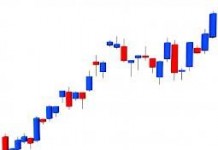The following is a basic introduction to recognising head and shoulders chart patterns when monitoring your favourite stocks, commodities, currencies and indices. This is a perfect pattern to start practising with as it is immediately actionable and can result in a series of profitable in-the-money binary trades.
The way Head and Shoulders works is by trying to spot three distinct peaks in your assets graph. These occur at the top of an uptrend and are good indicators of an imminent reversal. In other words they are a pretty good sign that a bull market is about to turn into a bear market. Usually when monitoring an asset that looks like it might soon experience a reversal the drop is not immediate but rather there are a few intermittent ups and downs before the reversal occurs.
What most traders keep their eyes out for is three peaks in close succession. So what you end up with is a peak followed by a drop, then another peak (that reaches a higher point than the first one) followed by a second drop, and then a third peak (this one will be lower than the second and close to the level of the first. The first and third peak make up the shoulders and the second higher peak makes up the head. So if you were to draw a line across the first and third peak you will have a shoulder line (this need not be completely straight, it can have up to a 30-45 degree tilt). This shoulder line is a good indicator that you are dealing with a Head and Shoulders pattern but it is not this line that you trade on.
Another line should be drawn at the bottom of the two peaks we just drew the shoulder line, this is the patterns neckline and this is where you should place a short term (or a series of short term) binary Put option(s) in order to have your trades finish in the money. A good place to get in for these sorts of trades is when you have correctly observed the head and shoulders and are monitoring the chart for signs that the second shoulder is about to be formed. If you see the price of the asset dropping closer and closer to a mark that would be your second shoulder then place your Put option.
Another thing to keep in mind here is that these bearish reversals are not going to last forever, and with timing being so central to binary options you really need to get your timing correct to be able to fully capitalise on this strategy. A good one to go for is to measure the distance between the head and the neckline and then trade aggressively for the same time it took the chart to move through these two points. So say it took 10 minutes to get from the head to the second shoulders lowest point, you then trade heavily from the neckline below the second shoulder for the next ten minutes.
Finally another good indicator that should confirm this strategy is if a Stochastics oscillator or RSI (more on these later) are indicating overbuying, or when this pattern occurs at or near a resistance level. That’s it for Heads and Shoulder. Go practise. Go play!















